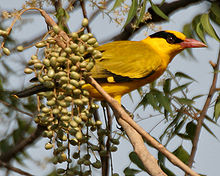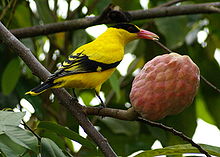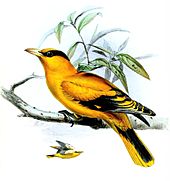- Black-naped Oriole
-
Black-naped Oriole 
Adult female diffusus (Hyderabad, India) Conservation status Scientific classification Kingdom: Animalia Phylum: Chordata Class: Aves Order: Passeriformes Family: Oriolidae Genus: Oriolus Species: O. chinensis Binomial name Oriolus chinensis
Linnaeus, 1766Synonyms Oriolus indicus
The Black-naped Oriole (Oriolus chinensis) is a bird of the oriole family and is found in many parts of Asia. There are several distinctive populations within wide distribution range of the species and in the past the Slender-billed Oriole (Oriolus tenuirostris) was included as a subspecies. Unlike the Golden Oriole which only has a short and narrow eye-stripe, the Black-naped Oriole has the stripe broadening and joining at the back of the neck. Males and females are very similar although the wing lining of the female is more greenish. The bill is pink and is stouter than in the Golden Oriole.
Contents
Identification
The Black-naped Oriole is medium sized and overall golden with a strong pinkish bill and a broad black mask and nape. The adult male has the central tail feathers tipped yellow and the lateral ones are more broadly yellow. The female has the mantle colour more greenish or olive. The juvenile has a streaked underside. The nestling has dull greenish with brown streaks. The head and nape are more yellowish and the undertail coverts are yellow. Several variations exist in the populations that have been separated as subspecies.[2]
Subspecies diffusus breeds in China and is widespread across India during winter, mainly in the northeastern parts and in the peninsular region. The population in the Andaman and Nicobar Islands are resident. The subspecies in the Andamans, O. c. andamanensis has all black wings while O. c. macrourus of the Nicobars has a very broad nape band so that only the top of the head is yellow. The wings are all black with a yellow primary covert patch. The calls of the Andaman and the Nicobar subspecies are said to be quite different, the latter having a more modulated call note.[3][4] The evolutionary history of this group of orioles is complex and there may be more cryptic species within the group.[5] In the Southeast Asian populations some geographic trends include a reduction of yellow on the forehead and a decreased brightness in the yellow plumage from north to south. Females from southern populations are more greenish on the back and tail and there are no yellow spots on the tips of the secondaries as in northern populations.[6]
The usual call is a nasal niee or myaa and the song (diffusus) is a fluty iwee wee wee-leeow. They have a dipping flight.[7]
Distribution and habitat
The Black-naped Oriole is found in forests, gardens and plantations. It feeds on berries and insects in the canopy. Subspecies diffusus breeds in eastern Siberia, Ussuriland, northeastern China, Korea and northern Vietnam and winters in Thailand, Burma and parts of India.[3] T. C. Jerdon described a bird from the Malabar region that he identified as Oriolus indicus[8] and this is now considered to be Oriolus chinensis diffusus.[9] Oriolus chinensis invisus is found in Southern Annam. The nominate population is from the Philippines. Several island populations have been described including suluensis (Sulu Island), melanisticus (Talaut Islands), formosus (Sangihe), frontalis (Sula Islands), sangirensis (Sangi Archipelago), saani (Moluccas), mundus (Simalur Island), sipora (Sipora Island), richmondi (Siberut and Pagi), insularis (Kangean), broderipii (Lombok, Sumba, Sumbawa, Flores, and Alor Islands), lampochryseus (Masalembo and Keramian Islands), oscillans (Tukang Besi Islands), boneratensis (Islands of Bonerate, Djampea and Kalao), maculatus (Singapore Island, Sumatra, Billiton, Banka, Nias, Java. Bali and Borneo), yamamurae (central and southern Philippines[10] and sometimes treated as identical to the nominate population), celebensis (northern Celebes) and macassariensis (southern Celebes).[11] The subspecies are very closely related and the group forms a clade in which the Eurasian Oriole and Indian Golden Oriole are also nested.[12][13]
Calls of O. c. diffusus in winter range
In winter populations breeding in eastern Asia winter in the tropical areas of Southeast Asia.[14] Subspecies diffusus is an uncommon migrant in many parts of South India and are most regularly seen in the Western Ghats.[5] In Singapore they are believed to have established as breeders only in the 1920s and are today common even within gardens in the city. In the 1880s they were considered rare.[15]
Behaviour and ecology
Black-naped Orioles have been recorded to feed on a range of berries including Trema orientalis, Ficus and others apart from insects. It has been suggested that they may have aided in the dispersal of Ficus species into the island of Krakatoa where they were also among the early pioneer species.[16] In India it has been noted to take nectar from large flowers such as those of Salmalia and Erythrina.[3] They can sometimes be nest predators on smaller birds.[17] The breeding season is April to June (January–March in the Nicobars[18]) and the nest is a deep cup in a fork of a tree.[5] The eggs, two to three, are salmon pin with reddish spots and darker blotches[2][19] The nests are often built in the vicinity of the nest of a Black Drongo. Two or three nests may be built by the female and one is finally chosen for laying eggs.[18] Males may sometimes sit beside the unused nests. Incubation is by the female alone and the eggs hatch after 14 to 16 days and the chicks fledge after another two weeks. Females stay closer to the nest, taking part in nest sanitation by removal of fecal sacs, driving away predators and feeding the young. The males take a more active role in feeding and guarding. Eurasian Tree Sparrows and Black Bulbuls may sometimes use abandoned nests. Nest predators include crows, treepies and hawks.[20] In many parts of Southeast Asia, they are trapped and sold in the bird trade.[21]
References
- ^ BirdLife International (2009). "Oriolus chinensis". IUCN Red List of Threatened Species. Version 3.1. International Union for Conservation of Nature. http://www.iucnredlist.org/apps/redlist/details/146764. Retrieved 17 January 2011.
- ^ a b Baker, ECS (1926). Fauna of British India. Birds. Volume 3 (2 ed.). London: Taylor and Francis. pp. 7–11. http://www.archive.org/stream/BakerFbiBirds3/BakerFBI3#page/n25/mode/1up.
- ^ a b c Ali S and SD Ripley (1986). Handbook of the birds of India and Pakistan. Volume 5 (2 ed.). New Delhi: Oxford University Press. pp. 104–108.
- ^ Butler, AL (1899). "The birds of the Andaman and Nicobar Islands. Part 1". J. Bombay Nat. Hist. Soc. 12 (2): 386–403.
- ^ a b c Rasmussen, P.C. & Anderton, J.C. (2005). Birds of South Asia. The Ripley Guide. Volume 2. Smithsonian Institution and Lynx Edicions. pp. 586–587.
- ^ Rand, AL (1951). "birds of Negros Island". Fieldiana Zoology 31 (48): 571–596. http://www.archive.org/stream/birdsofnegrosisl3148rand#page/591/mode/1up/.
- ^ Brazil, Mark (2009). Field Guide to the Birds of East Asia.. London: Christopher Helm. pp. 300–301. ISBN 0713670401.
- ^ Jerdon, TC (1863). The Birds of India. Volume 2. Part 1. Military Orphan Press, Calcutta. pp. 109–110. http://www.archive.org/stream/birdsofindiabein21jerd#page/109/mode/1up/.
- ^ Dickinson, EC; RWRJ Dekker; S Eck & S Somadikarta (2004). "Systematic notes on Asian birds. 43. Types of the Oriolidae". Zool. Verh. Leiden 350: 65–84. http://www.naturalis.nl/sites/naturalis.en/contents/i000308/snab043.pdf.
- ^ Goodman SM & D E Willard (1995). "The birds of Sibuyan Island, Romblom province, Philippines, with particular reference to elevational distribution and biogeographic affinities.". Fieldiana Zoology 82: 1–57. http://www.archive.org/stream/birdsofsibuyanis82good#page/29/mode/1up.
- ^ Greenway J.C, Jr. (1962). "Family Oriolidae". In Mayr, E and Greenway JC, Jr.. Check-list of birds of the World. Volume 15. Museum of Comparative Zoology, Cambridge. pp. 122–137. http://www.archive.org/stream/checklistofbirds151962pete#page/128/mode/1up.
- ^ Knud A. Jønsson, Rauri C. K. Bowie, Robert G. Moyle, Martin Irestedt, Les Christidis, Janette A. Norman and Jon Fjeldsa (2010). "Phylogeny and biogeography of Oriolidae (Aves: Passeriformes)". Ecography 33: 232–241. doi:10.1111/j.1600-0587.2010.06167.x. http://www.nrm.se/download/18.25ba04a21296cc434f980005871/J%C3%B6nsson+et+al+Oriolidae.pdf.
- ^ Dickinson, EC (2000). "Systematic notes on Asian birds. 7. Black-naped Oriole Oriolus chinensis Linnaeus, 1766: some old nomenclatural issues explained". Zoologische Verh., Leiden 331: 131–139. http://www.repository.naturalis.nl/document/46283.
- ^ Robinson, H.C. (1927). The Birds of the Malay Peninsula. Volume 1: The Commoner Birds. London: Witherby. pp. 273–274. http://rmbr.nus.edu.sg/biblio/robinson_chasen/vol1/51_Orioles.pdf.
- ^ Ward P (1968). "Origin of the avifauna of urban and suburban Singapore". Ibis 110 (3): 239–255. doi:10.1111/j.1474-919X.1968.tb00036.x.
- ^ Ian W. B. Thornton, Stephen G. Compton, Craig N. Wilson (1996). "The role of animals in the colonization of the Krakatau Islands by fig trees (Ficus species)". J. Biogeography 23 (4): 577–592. doi:10.1111/j.1365-2699.1996.tb00019.x.
- ^ Wee, Y. C. (2009). "Observations on the behaviour of the Yellow-vented Bulbul (Pycnonotus goiavier (Scopoli) in two instances of failed nesting". Nature in Singapore 2: 347–352. http://rmbr.nus.edu.sg/nis/bulletin2009/2009nis347-352.pdf.
- ^ a b Sivakumar K (2003). "Some observations on the breeding biology of birds on Great Nicobar Island, India". Forktail: 130–131. http://www.orientalbirdclub.org/publications/forktail/19pdfs/Sivakumar-Nicobar.pdf.
- ^ Herklots, GAC (1936). "The birds of Hong Kong. Part 23". The Hong Kong Naturalist 7 (2): 99–101. http://sunzi.lib.hku.hk/hkjo/view/27/2700365.pdf.
- ^ Li-ching Chu (2007). Study of Breeding Biology and Habitat Use of Black-naped Oriole (Oriolus chinensis). Unpublished Masters Thesis, National Sun Yat-Sen University, Taiwan. http://etd.lib.nsysu.edu.tw/ETD-db/ETD-search/getfile?URN=etd-0213107-155607&filename=etd-0213107-155607.pdf.
- ^ Shepherd, CR; Jeet Sukumaran, Serge A. Wich (2004). Open Season: An analysis of the pet trade in Medan, Sumatra 1997 - 2001. TRAFFIC Southeast Asia. http://www.traffic.org/general-reports/traffic_pub_trade5.pdf.
External links
Categories:- IUCN Red List least concern species
- Oriolidae
- Birds of Asia
Wikimedia Foundation. 2010.





